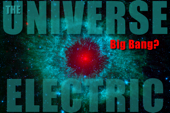Another Thornhill Prediction Confirmed - Saturn's Hot Spot
01/10/2008
On February 5, 2005, Australian
physicist Wallace Thornhill, co-author of The Electric Universe and
Thunderbolts of the Gods, published on his website (Holoscience.com)
his analysis of scientists' discovery of a "warm polar vortex at
Saturn's south pole." Thornhill offered a detailed electrical
interpretation of the phenomenon, and chastened investigators for
referring to the "vortex" as "the first to ever be discovered in the
solar system."
He
wrote:
"Keck researchers don't seem to have done their homework.
Or maybe things that can't be explained get forgotten! Saturn's
'warm polar vortex' is not 'the first to ever be discovered.'
The Pioneer Venus Orbiter (PVO) discovered a warm 'giant vortex of
surprisingly complex structure and behaviour located in the middle
atmosphere at the north pole of the planet, with a similar feature
presumed to exist at the south pole also.'"
On the question of Saturn's strange polar "hot spot," Thornhill
offered an explicit prediction: "The Electric Universe also
predicts, experimentum crucis, that both poles should be
hot, not one hot and the other cold."
On January 3, 2008, the Reuters news service published the science
headline, "Scientists find hot spot on Saturn's chilly pole":
"Saturn's chilly north pole boasts a hot spot of compressed air, a
surprising discovery that could shed light on other planets within
our own solar system and beyond, researchers said on Thursday.
"Scientists already knew about a hot spot at Saturn's sunny south
pole but data from the Cassini spacecraft now shows that the winter
pole drenched in darkness also has a hot spot, said Nick Teanby, a
planetary scientist, who worked on the study."
"We didn't expect it to have a hot spot at the north," said Teanby
of the University of Oxford.
Saturn's north polar "hot spot" is a total "surprise" to planetary
scientists, because the pole has been deprived of sunlight since its
winter began more than twelve years ago! Baffled investigators can
only propose a strange theory based on the mechanics of wind and
water: "The hot spots are the result of air moving polewards, being
compressed and heated up as it descends over the poles into the
depths of Saturn," said Leigh Fletcher, a planetary scientist from
the University of Oxford, England, and the lead author of the
Science paper. "The driving forces behind the motion, and indeed the
global motion of Saturn's atmosphere, still need to be understood."
But in the minds of electric universe proponents, no understanding
of these "surprising" atmospheric phenomena is possible for
scientists if they continue to deny all things electrical. The idea
that the "hot spot" is due to the compression of air is of course
just a wild guess, because the theorists have no other resort than
standard gas laws. Yes, when air is compressed within a container,
it gets warmer; when pressure is released, it gets cooler. But they
never anticipated such a phenomenon on Saturn, nor does it appear
that they've measured such a thing, either.
From the electrical perspective, it is not coincidental that the hot
spot is located "smack dab in the center of the north pole vortex."
Like Venus' polar vortexes, Saturn's north polar hot spot -- and the
vortex structure in which it is located -- is created by a flow of
electric current along magnetic field lines to the pole. It's also
worth noting that NASA scientists could not apply their explanation
of the north polar anomaly to the counterpart at the south pole. The
boundaries between temperature regions at the south polar vortex
were entirely enigmatic. The original Keck release wrote: "...both
the distinct boundary of a warm polar vortex some 30 degrees
latitude from the southern pole and a very hot 'tip' right at the
pole were completely unexpected." Of course, no one could plausibly
suggest that such sharp temperature boundaries could be due to
"atmospheric compression."
It has been said that the credibility of any hypothesis lies in its
predictive record. While mainstream planetary scientists are
"surprised" at the discovery of Saturn's north polar "hot spot"
(just as they never anticipated the twin Venusian polar vortexes),
the hot spot was explicitly predicted by Thornhill, the leading
proponent of the Electric Universe.
Many within the Thunderbolts circle are wondering what it will take
to shake mainstream astronomers and planetary scientists from their
refusal to consider the viable, testable hypotheses of the Electric
Universe. This latest confirmed prediction by Thornhill is only one
in a long series of such successes. These include:
Venusian lightning
For decades, most scientists believed that Venusian lightning was
precluded due to the density of the planet's atmosphere (a Space.com
report in 2001 declared "No
Lightning" on Venus). Many in the mainstream argued that the
apparent detections of lightning on Venus -- dating back to the
1970's -- must have been illusory since the available technology,
they claimed, could not differentiate between lightning and other
ionospheric processes. But for well over 10 years, Thornhill argued
that Venus showed substantial evidence of electrical interaction
with its environment, and that lightning on Venus was expected in an
electric universe. (To see Thornhill's debate on Venusian lightning
with Tim Thompson, see the
May 21, 1997 edition of THOTH).
The Deep Impact event
In October 2001, after the announcement of NASA's 2005 Deep Impact
mission, Thornhill wrote:
"Given the erroneous standard model of
comets it is an interesting exercise to imagine what surprises are
in store for astronomers if the plan is successful. The electrical
model suggests the likelihood of an electrical discharge between the
comet nucleus and the copper projectile, particularly if the comet
is actively flaring at the time. The projectile will approach too
quickly for a slow electrical discharge to occur. So the
energetic effects of the encounter should exceed that of a
simple physical impact, in the same way that was seen with comet
Shoemaker-Levy 9 at Jupiter."
Twenty-four hours before the impact event, in collaboration with the
Thunderbolts.info group, Thornhill predicted that an electrical
"flash" might precede the impact and explosion, and that the
explosion would be far more energetic than NASA anticipated. And
this is precisely what happened on July 4, 2005, much to the
astonishment of NASA and astronomers around the world.
Other
successful Thornhill predictions included:
- a lack of increase in
water production in the cometary coma (indicating a lack of
subsurface water anticipated by astronomers);
- an unexpected lack of
ice on the comet nucleus, or water in the immediate ejecta from
impact;
- a sculpted comet surface with sharply defined craters,
valleys, mesas, and ridges (the precise opposite of what one
expects of a "dirty snowball");
- a rearrangement of the comet's jets
due to charge distribution.
Jupiter's Electric Moon Io
Following the lead of earlier investigators Dr Thomas Gold (The
Journal Science, Nov 1979), Dr. Anthony Peratt and Professor AJ
Dessler (Astrophysics and Space Science, no. 144 - 1988), Thornhill
insisted that the so-called "volcanoes" on the Jovian moon Io are
actually electric discharge plumes. Prior to the Galileo probe's
1996 arrival in the Jovian system, Thornhill registered these
advance claims:
- the vents of Io's "volcanic"
plumes will be much hotter than lava;
- the plumes are the jets of
cathode arcs, and they do not explode from a volcanic vent but
move around and erode the periphery of dark areas (called "lava
lakes" by planetary geologists);
- the "lava lakes" themselves are
merely the solid surface of Io etched electrically by cathode
arcs and exposed from beneath the "snow" deposited by continuous
discharge activity. Therefore, they will not reveal the expected
heat of a recent lava flow.
Each of these predictions received
stunning confirmation. Io's "volcanic" hot spots were not only
hotter than any lava on Earth, but were too hot to be measured by
Galileo's instruments (no "lava flow" ever recorded has produced
temperatures as hot as seen in the original Galileo image). Also as
predicted by Thornhill, the discharging was found to be focused on
the edges of the so-called "lava lakes," though the rest of these
dark fields are comparatively cold. None of the expected volcanic
vents could be found. Rather, some of the "volcanic" plumes are
actually MOVING across the surface of Io! The plume of the "volcano"
Prometheus has moved more than 80 kilometers since the Voyager
mission.
Inspiring further astonishment amongst mission scientists, the
"volcanic" plumes emit ultraviolet light -- something inconceivable
under normal conditions of volcanic venting. But ultraviolet light
is of course characteristic of an electric arc.
More recently, observations have added direct confirmation to the
electrical connection between Jupiter and Io. A recent image of the
Tvashtar "volcano" near the north pole of Io reveals a plume
extending 290 kilometers above the surface. The language of the NASA
report strikingly features the language of the electrical theorists:
"The
remarkable filamentary structure in the Tvashtar plume is
similar to details glimpsed faintly in 1979 Voyager images of a
similar plume produced by Io's volcano Pele. However, no previous
image by any spacecraft has shown these mysterious structures
so clearly." (emphasis added).
"Filamentary structure" simply does not belong in "volcanic" plumes,
but as noted by Gold, Peratt, and Dessler, it is a distinctive
feature of the "penumbra" of an electric discharge.
Martian Dust Devils

In the Thunderbolts Picture of the
Day for November 9, 2005, “When Dust Storms Engulf Mars,” a claim
was asserted flatly contradicting the theoretical assumptions of
conventional astronomers, meteorologists, and planetary scientists.
Taking a pointer from Thornhill, the Thunderbolts group stated that
the global dust storm that engulfed the planet Mars in August and
September of 2001, involved a packed assembly of “dust devils”
carrying great volumes of Martian dust into billowing clouds.
Since publication of that TPOD, a review of dust storm images from
the Mars Global Surveyor and from THEMIS, together with a systematic
study of related phenomena on Mars, has confirmed that the statement
was accurate. And yet it is also clear that the concept of compact
“dust-devil congregations” could only appear absurd to conventional
schools. In standard theory an atmospheric vortex requires a vastly
larger circulation of wind, a condition that precludes what seems
clearly to be seen in edge-on pictures of "storm fronts" on Mars.
The image above, released December 30, 2003, shows apparent vortices
(a word that would not be used by NASA scientists) rising into
billowing clouds from the margins of the south polar ice cap in the
Martian summer. The caption accompanying the release, reads: "Like
billowing smoke from a brush fire, clouds of dust are seen streaming
off the edge of the Martian south polar cap. The southern hemisphere
is in the middle of its summer season and experiencing a multitude
of small dust storms like this one. The net effect is an
increasingly dusty atmosphere across the whole planet and with it,
warmer atmospheric temperatures."
Here again, as noted in the May 7, 2007 TPOD, planetary scientists
imply that it is the raised clouds themselves that produce the
warmer temperatures. For this claim there is simply no evidence. But
the dramatic rise of temperature simultaneously with large regional,
or global storms, cannot be disputed. It is the cause that remains a
mystery to NASA scientists.
Saturn's Moon Titan
In December of 2004, Thornhill predicted that spidery ravine
networks ("Lichtenberg" forms) would be seen on Titan, not unlike
the "arachnoids" on Venus. He also stated it was unlikely that large
craters would be observed, although mainstream investigators were
expecting them in abundance. In the standard view of Titan, the moon
is billions of years old, allowing plenty of time for massive
impacts to scar the surface. In Thornhill's opinion, Titan shares a
similar history to that of Venus -- both were born very recently by
electrical ejection from a gas giant. A recent birth also removes
the need for a global hydrocarbon ocean to supply, over billions of
years, the methane observed in Titan's atmosphere (methane is
destroyed in the atmosphere by sunlight). That too was born out when
the Huygens probe landed on a solid surface in what looked
conventionally to be a drainage basin. However the channels leading
to that basin have the distinctive apearance of surface lightning
scars. They were not carved by a flowing liquid.
To date, images returned of Titan reveal that large craters are
almost non-existent. What they do show are the very
Lichtenberg patterns of electrical discharge Thornhill had
anticipated.
The above explicit predictions by Thornhill are in addition to a
seemingly endless string of recent discoveries and observations that
follow logically from the Electric Universe model. These include:
- The Electric/Sun Earth
Connection - NASA's THEMIS spacecraft recently
observed giant, "magnetic ropes" that reached all the way from
the earth to the Sun. But the "ropes" to which mainstream
investigators referred are commonly described in plasma science
as
electrical Birkeland currents.
- Great Cosmic "Voids" -
Scientists' recent observation of an "impossibly" huge "void"
only highlights the Big Bang theory's inherent implausibility.
While the discovery of the apparent "void" has left the
mainstream to ponder such bizarre, esoteric explanations as "parallel
universes," such "voids" are best explained as cellular
plasma voids.
- The "Mystery" of
ultra-high-energy Cosmic Rays - Standard theory has
never succeeded in explaining the rays, which are thought to
originate from far beyond our galaxy yet somehow make it all the
way to Earth. Two scientists have proposed that the rays are
"powered" by "magnetised cocoons of plasma" that were formed by
jets of high-speed particles supposedly emitted by a "supermassive
black hole." But in the Electric Universe, they almost certainly
originate in our own cosmic neighborhood, within the Milky Way,
as a result of electrical discharge events well-modeled by
plasma cosmologists.
- The "Amazing" Outburst of
Comet Holmes 17P - "This is truly a celestial
surprise"..."Absolutely amazing," said Paul Lewis, director of
astronomy outreach at the University of Tennessee.
This was a typical reaction of the astronomical mainstream to
the sudden,
unfathomable brightening of Comet Holmes 17P. In the span of
a few days, the comet's coma grew to such an enormous and bright
disk that it could be seen with the naked eye, though it never
gets as close to the Sun as the planet Mars, and when it
suddenly erupted, it was moving AWAY from the Sun. As the
structure of the coma clarified itself, jets appeared streaming
away from the center. The source of the jets was entirely
enigmatic, if not preposterous through the lens of the usual
comet assumptions. Nor can scientists, using the puny force of
gravity, explain the ability of the comet to hold in place its
colossal spherical coma, which grew bigger than the Sun to well
over 2 million miles in diameter.
The purpose of this compilation is to
illustrate that the Electric Universe hypothesis has a powerful
record of both explicit and logical predictions -- unlike the
esoteric, mathematically "elegant" inventions that dominate
mainstream astronomy, which have successfully predicted virtually
nothing. No excuse remains for astronomers and science media to
plead ignorance of the model's successes. If a New Year's resolution
is in order for the scientific mainstream, it is to finally take
proper notice of the Electric Universe and its ability to foresee
space age discovery.
Permalink to this article.
Public comment may be made on this article on the
Thunderbolts Forum/Thunderblogs (free membership required).
For a highly-acclaimed 60-minute video introduction to the Electric Universe, see
Thunderbolts of the Gods on Google Video.
|

Michael Goodspeed is a freelance journalist who lives in Beaverton, Oregon
My Archives
Chronological Archives
Archives by Author
Archives by Subject
Thunderblogs home
|





